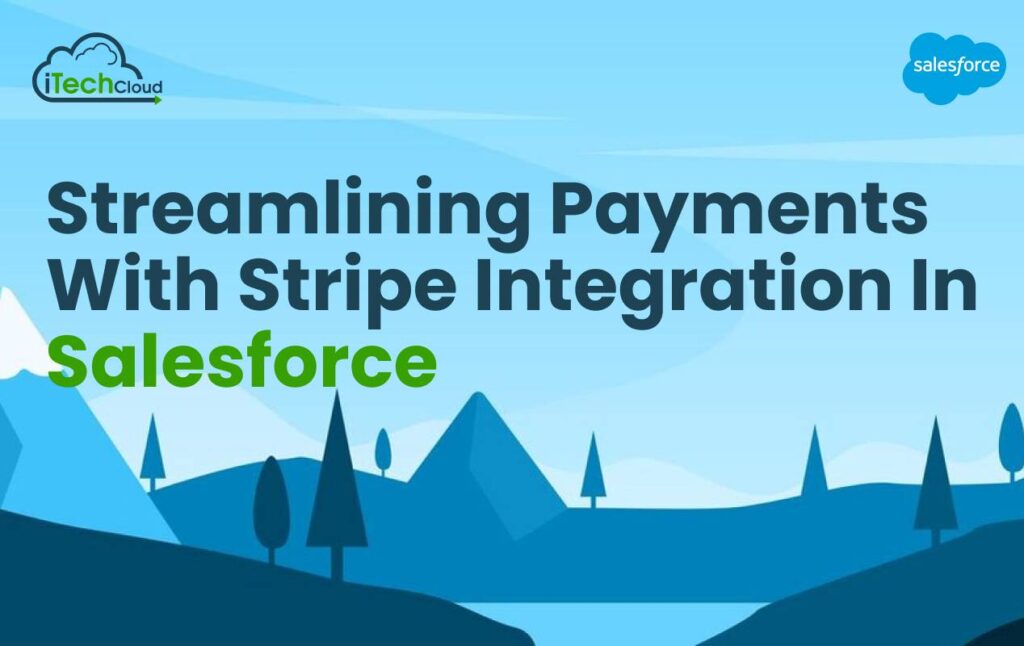Stripe Integration in Salesforce

Stripe Integration in Salesforce streamlines payment processing within the CRM platform, enhancing sales and finance operations. By embedding Stripe’s secure payment gateway, businesses can accept online payments seamlessly through Salesforce, enabling efficient transaction management and real-time updates on payment statuses. This integration facilitates a cohesive workflow, allowing sales teams to generate invoices, process payments, and track revenue within Salesforce, eliminating the need for manual data entry across multiple systems.
Understanding Stripe Integration in Salesforce
Stripe Integration in Salesforce revolutionizes payment processing within the CRM ecosystem, merging customer relationship management with seamless transaction capabilities. This fusion empowers businesses to manage sales and revenue streams effortlessly, all within the familiar Salesforce interface. Stripe Integration in Salesforce robust payment infrastructure, organizations gain real-time insights into financial transactions, enhancing decision-making and customer interactions. The integration offers a scalable solution that adapts to diverse business needs, facilitating secure online payments, subscription management, and revenue tracking without the hassle of switching between platforms.
Table of Contents
Key Benefits of Stripe Integration in Salesforce
Stripe Integration in Salesforce can significantly enhance your business operations, streamlining payment processes and improving overall efficiency.
Here are some overview of the key benefits:
1. Payment Processing:
Stripe Integration in Salesforce, you can accept payments directly within your CRM platform. This seamless integration eliminates the need for manual data entry or switching between different systems, saving time and reducing errors.
2. 360-Degree View of Customers:
Stripe Integration in Salesforce, you gain a comprehensive view of your customers’ payment history, preferences, and interactions. This holistic view enables you to tailor your sales and marketing efforts more effectively, providing personalized experiences and increasing customer satisfaction.
3. Automated Billing and Invoicing:
Salesforce integration with Stripe allows for automated billing and invoicing processes. You can set up recurring payments, send invoices automatically, and track payment status directly from your CRM platform. This automation reduces administrative overhead and ensures timely payments, improving cash flow for your business.
4. Reporting and Analytics:
Stripe Integration in Salesforce, you can generate detailed reports and analytics on sales performance, revenue trends, and customer behavior. By analyzing this data within your CRM platform, you can identify opportunities for growth, optimize pricing strategies, and make data-driven decisions to drive business success.
5. Improved Customer Engagement:
Integration of Stripe with Salesforce enables you to deliver a seamless and personalized customer experience. You can set up automated payment reminders, trigger targeted marketing campaigns based on purchase behavior, and provide proactive customer support for payment-related inquiries. This enhanced engagement fosters stronger customer relationships and increases loyalty over time.
6. Subscription Management:
Stripe Integration in Salesforce streamlines subscription management processes. You can easily manage subscriber information, handle upgrades or downgrades, and track subscription metrics directly within your CRM platform. This centralized approach improves operational efficiency and ensures a smooth customer experience throughout the subscription lifecycle.
7. Scalability and Flexibility:
Stripe API robust payment infrastructure combined with Salesforce’s scalable CRM platform provides the flexibility to adapt to your business’s evolving needs. Whether you’re a small startup or a large enterprise, the integration offers scalability to accommodate growth and support complex payment workflows. You can customize payment processes, automate workflows, and integrate additional third-party apps as needed to optimize your business operations.
8. Compliance and Security:
Stripe Integration in Salesforce is renowned for its industry-leading security standards and compliance certifications, including PCI DSS compliance. Stripe Payment Integration in Laravel, you can leverage these security features to ensure the safety of customer payment data and comply with regulatory requirements. This instills trust and confidence among your customers, enhancing your brand reputation and mitigating risks associated with payment processing.
9. Reduced Churn and Increased Retention:
Salesforce Stripe integration, you can leverage Stripe data to identify at-risk customers and implement targeted retention strategies. By analyzing churn patterns, offering personalized incentives, and providing proactive support, you can reduce churn rates and increase customer retention over time. This proactive approach to customer management helps maximize the lifetime value of each customer and drive sustainable growth for your business.
10. Sales and Marketing Teams:
Stripe Integration in Salesforce empowers your sales and marketing teams with valuable payment insights and customer data. Sales representatives can access real-time payment information, track revenue metrics, and prioritize leads based on payment history. Marketing teams can segment customers, personalize communications, and measure campaign effectiveness using payment data integrated into Salesforce. This alignment between sales, marketing, and finance functions enables cross-departmental collaboration and drives overall business success.
Best Practices For Stripe Integration in Salesforce
Stripe Integration in Salesforce requires careful planning and execution to ensure a seamless and efficient process. Here are some best practices to follow now:
1. Define Integration Objectives:
Before diving into the integration process, clearly define your objectives and goals. Determine what you aim to achieve Stripe Integration Salesforce, whether it’s streamlining payment processes, gaining deeper customer insights, or improving operational efficiency. Setting clear objectives will guide your integration strategy and help measure its success.
2. Data Mapping Requirements:
Take the time to understand the data mapping requirements between Stripe Integration Salesforce. Identify the key data points that need to be synchronized, such as customer information, payment details, and transaction history. Ensure consistency in data formatting and mapping to avoid discrepancies or errors during integration.
3. Choose the Right Integration Method:
Salesforce offers various integration methods for connecting with external systems like Stripe, including REST APIs, SOAP APIs, and third-party integration tools. Evaluate the requirements of your integration project and choose the method that best suits your needs in terms of functionality, scalability, and ease of implementation.
4. Implement Secure Authentication:
Security is paramount when integrating payment systems like Stripe Connector for Salesforce Platform. Implement secure authentication mechanisms, such as OAuth or API keys, to ensure that only authorized users and applications can access sensitive payment data. Follow Stripe’s security best practices and adhere to industry standards like PCI DSS to protect customer payment information.
5. Handle Errors and Exceptions:
Plan for error handling and exception management during the integration process. Anticipate potential issues such as network errors, data validation failures, or API rate limits, and implement mechanisms to handle these scenarios gracefully. Use logging and monitoring tools to track integration errors, diagnose issues, and troubleshoot problems in real-time.
6. Optimize Performance and Scalability:
Design your Integrate Stripe Billing with Salesforce for performance and scalability to handle large volumes of payment transactions and data. Consider factors such as API rate limits, data caching, and asynchronous processing to optimize system performance and minimize latency. Monitor system performance metrics regularly and implement optimizations as needed to ensure scalability as your business grows.
7. Implement Data Privacy and Compliance Measures:
Ensure compliance with data privacy regulations such as GDPR, CCPA, and PCI DSS when integrating Stripe with Salesforce. Implement data encryption, access controls, and data retention policies to protect sensitive customer information and maintain regulatory compliance. Work closely with legal and compliance teams to ensure alignment with relevant data protection laws and regulations.
8. Test Thoroughly Before Deployment:
Conduct comprehensive testing of your integration solution before deploying it into production. Perform unit tests, integration tests, and end-to-end tests to validate data accuracy, functionality, and performance. Use test environments and sandbox accounts provided by Stripe for Salesforce Platform to simulate real-world scenarios and identify potential issues early in the development lifecycle.
9. Provide User Training and Documentation:
The Stripe Integration in Salesforce through training sessions and documentation. Provide clear instructions on how to use the integrated features, access payment data, and troubleshoot common issues. Empower users with the knowledge and resources they need to leverage the integration effectively and maximize its benefits.
10. Monitor and Maintain the Integration:
The integration is deployed, establish a process for ongoing monitoring, maintenance, and support. Monitor system performance, API usage, and data synchronization to proactively identify and address any issues that arise. Stay informed about updates and new features released by Stripe Connectors for Salesforce, and keep your integration solution up to date to ensure compatibility and continued functionality.
Case Studies For Stripe Integration in Salesforce
1. Event Management Company
Background:
An event management company specializes in organizing large-scale conferences and trade shows. They handle event registrations and ticket sales through Stripe and manage customer relationships through Salesforce.
Integration Objectives:
- Streamline event registration and payment processing.
- Gain insights into attendee demographics and ticket sales.
- Improve communication and engagement with event participants.
Implementation:
The event management company Stripe Integration in Salesforce using REST APIs to synchronize attendee data, payment information, and event registration details. They map relevant fields such as attendee name, email, ticket type, and payment status to ensure seamless data integration between the two systems.
Benefits:
1. Event Registration Process:
Stripe Integration in Salesforce, attendees can register for events and purchase tickets seamlessly through the company’s website or mobile app. Payment information is automatically synced with Salesforce, allowing event organizers to track registrations, process payments, and send confirmation emails in real-time.
2. Deeper Insights into Attendee Behavior:
Stripe Integration in Salesforce, the event management company gains valuable insights into attendee demographics, ticket sales trends, and revenue metrics. They can identify popular sessions, track ticket sales by category, and segment attendees based on registration history, enabling more targeted marketing and event planning efforts.
3. Improved Attendee Engagement:
Stripe Integration in Salesforce, the event management company can personalize communications and engage with event participants more effectively. They can send targeted emails, event reminders, and post-event surveys based on attendee preferences and registration status, fostering stronger relationships and driving higher attendance rates for future events.
2. Nonprofit Organization
Background:
A nonprofit organization raises funds through online donations processed via Stripe and manages donor relationships through Salesforce.
Integration Objectives:
- Simplify online donation processing and tracking.
- Gain insights into donor behavior and contribution patterns.
- Enhance donor stewardship and engagement efforts.
Implementation:
The nonprofit organization integrates Stripe with Salesforce using webhooks and REST APIs to synchronize donor information, donation transactions, and fundraising campaigns. They map relevant fields such as donor name, email, donation amount, and campaign attribution to ensure accurate reporting and tracking within Salesforce.
Benefits:
1. Donation Processing:
Stripe Integration Salesforce, donors can contribute to fundraising campaigns securely and conveniently through the organization’s website or donation portal. Donation transactions are automatically recorded in Salesforce, allowing the nonprofit to track contributions, issue tax receipts, and acknowledge donors promptly.
2. Insights into Donor Giving Patterns:
Stripe Integration Salesforce, the nonprofit organization gains insights into donor behavior, giving patterns, and campaign effectiveness. They can identify top donors, track donation trends over time, and segment donors based on contribution history, enabling more targeted fundraising appeals and cultivation strategies.
3. Personalized Donor Stewardship:
Stripe Integration Salesforce, the nonprofit organization can personalize donor stewardship efforts and strengthen relationships with supporters. They can send personalized thank-you messages, impact updates, and invitations to exclusive events based on donor preferences and engagement history, fostering a sense of connection and loyalty among donors.
Conclusion:
The Stripe Integration Salesforce offers a transformative solution for businesses seeking to streamline payment processes, enhance customer insights, and drive operational efficiency. By seamlessly connecting these two powerful platforms, organizations can achieve a wide range of benefits, including automated billing and invoicing, real-time payment tracking, and personalized customer engagement.
Through Stripe Integration Salesforce, businesses can optimize sales and marketing efforts by leveraging comprehensive payment data within Salesforce to tailor campaigns, identify high-value customers, and drive revenue growth. Additionally, the ability to manage subscriptions, process refunds, and handle disputes directly within Salesforce enhances operational efficiency and reduces manual overhead.
Moreover, the security and compliance features of both stripe and slack ensure the protection of sensitive payment information and adherence to regulatory standards, instilling trust and confidence among customers and stakeholders.
Overall, Stripe Integration Salesforce represents a strategic investment for businesses looking to stay competitive in today’s digital landscape. By harnessing the combined capabilities of these platforms, organizations can unlock new opportunities for growth, improve customer experiences, and drive sustainable business success.

